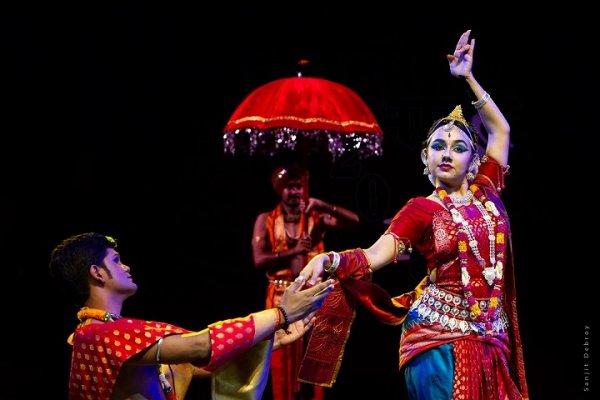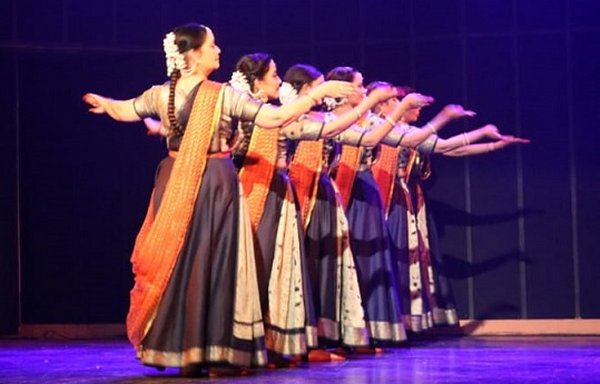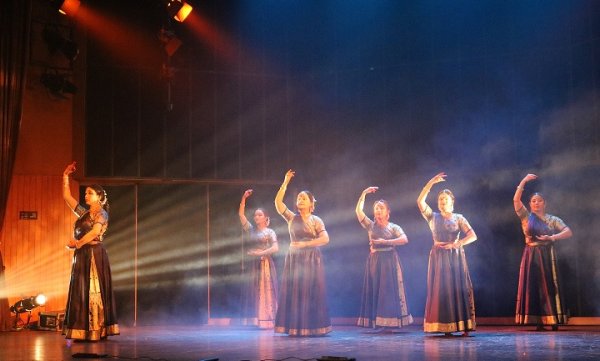
|   |

|   |
 e-mail: leelakaverivenkat@gmail.com Impresario evening impresses April 9, 2019 While large audiences for dance recitals have become rare, Impresario India continues to impress with good responses to all its shows. Over the years, the organization has developed a very faithful clientele of members and well-wishers. This for me stands out as one of the finest achievements of the organization. Its annual festival sponsoring new choreographies, was this year restricted to just one day with two productions featured - Tagore's Chitrangada visualized as a Nritya Natika in Odissi by Ranjana Gauhar and Saptaavart in the Kathak style produced and visualized by Prerana Shrimali - both proving to be laudable presentations.   Chitrangada A highly evolved work as compared to the earlier version of Chitrangada presented by Ranjana Gauhar's institution some years ago, the latest production with script and direction by Ranjana Gauhar, had uniformly proficient dancing, with no grey areas. Action begins with the female soldiers from the army of Princess Chitrangada, daughter of the royal house of Manipur, sporting very artistically designed turbans, going through a drill with Hatha Yoga postures (held with good bodily control) essaying movements of the Hathya dhara Chhau technique. Contrasting with this activity driven group is the figure of Arjun in deep meditation during his period of exile when he has taken a vow of celibacy. One look at the comely, still figure and Princess Chitrangada loses her heart to the man she immediately places as Arjun. Dancer Vrinda Chadha as Chitrangada very convincingly conveyed the loneliness, and then curiosity followed by the sudden attraction towards Arjun in the Tagore songs "Bodhu kon aalo laglo chhokhey" and then "Khhawney khhawneey mon e mone, shuni awtawlo jawlero aobhan". But Arjun is indifferent to her advances, bound by his vow of celibacy (Brahmachari vritha dhori). Meanwhile the warriors, sans turban, exult in their natural femininity - bathing and having fun in the river water splashing it over one another. Convinced about her inability to sway Arjun's mind to her general lack of physical allure, Chitrangada prays to Madana, the God of love, enacted by Nainika Prakash, to grant her a boon of irresistible physical beauty, for one year. And lo and behold, the boon is granted and soon the transformation happens. Unobtrusively and skillfully managed on stage, Sanchita Roy in the role of the beauteous Chitrangada takes over the dance narrative, evocatively communicating the seductive change coming over her, with each part of her body in song - as she ecstatically dances to "Amar angey angey ke bajay banshi" (feeling like flute music playing in every organ of her body). Arjun falls spell to her allure. But even in the throes of this idyllic love, Chitrangada finds it deceitful. Calling out "Esho esho jehosho hoi" to Madana again, she wants him to spare her this constant duplicity. Once again it is Chitrangada in her natural form taking over, letting Arjun know that the woman he desired was not real. Taking pride in her real identity, Chitrangada declares her true self "Ami Chitrangada." Arjun meanwhile having been treated to the disturbance and unease among the subjects due to attack from the neighbouring kingdom, successfully quelled by Princess Chitrangada who restores peace, has his eyes and mind opened to the real worth of this woman - which goes much beyond skin deep beauty. Arjuna communicates his new clarity of mind "Keno re klanti ashey abesho bhar bohiya.....Keno re." In the role of Arjun, the Trinidadian Odissi dancer Vinod Kevin Bachhan was well chosen - given his suitable presence and stature along with good Odissi technique. What however could be improved upon is more animation in the expressional aspect - which for one coming from another culture perhaps needs more familiarizing with the episodes from myth and literature our dancers are frequently drawn to. The dancers involved in the group sequences Ankita Bakshi, Swati Jakhmole, Shambhavi Gupta and Archishya Aryo combined well. The script in English by Ranjana Gauhar, with the dramatized narration in voices of Avery Chaurey, Sangeeta Bahadur and Parnendu, was to the point and did not stand out like an external sore thumb. The choreography was such that action at an easy pace did not allow the story to stagger at any point. The music by Saroj Mohanta was well conceived and recorded with melodic voices which did not lack in emotive persuasion. One appreciated the sensitive handling of Tagore lyrics which in catering to meter and rhythm set by the Odissi mardala did so without hiccups, particularly for the Bengali fans sensitized to Tagore's music. Costumes were aesthetic and altogether a work with professionalism and finish. Saptaavart The nine planets or Navagraha, became seven in number in Saptaavart as envisioned by Prerana Shrimali, whose Kathak tale on the grihas left out the two planets Rahu and Ketu - sometimes placed together and at others functioning in separate orbits. Planetary orbits, an excellent theme for Kathak rhythmic arithmetic with its chakkars at varying speeds was here looked at more philosophically -in colours astrology allots to them (managed through dupatta colours of the costume changed between scenes), emotive states associated with each of them and how they influence human behavior.   Saptaavart The starting point was with six dancers one behind the other in a line in orange dupattas, with hands rotating clockwise and anticlockwise, representing Surya or the Sun - the prime energy giver for life on earth with the five cosmic elements. Based on the Surya Tatva Slokam, Earth or Prithvi is conceived as paying salutations to the Sun - "Brahma Sashvatam". The fiery nature of the planet is expressed through the energy of tala Dhamar in 14 matras, the music set to raag Vibhas. Chandra was represented through dancers in light blue dupattas - this planet being associated with erotic emotions of love, also representing love in vatsalya -i.e of the mother for the child. Set to ragas Hameer, Kedar and Chhayanut, the mother here is shown responding to the wonder child asking her to fetch the deer seen on the moon! (Chhand khilona le ho - Anokha laadla hiren ko mange Shyam). For sensitive abhinaya, Prerana largely depended on her own solo appearances. Mangal once again was fiery energy, draped in red colour, the executed bandishes by the group reveling in chalangs (jumps) while anchored in the centre (the black and red colour contrast making a visual treat in the formations) was a supremely energetic dancer executing chakkars at varying speeds. Planet Budha, represented in green dupatta, is believed to preside over mental qualities - excellence of intellect and mind. The choreographer very intelligently veering the dance narrative away from the virtuosity of rhythm went on to the subtlety of Gats - both Gat bhav and Gat nikas with the language of hand symbols giving the message. Then came the "Na dhin dhin na" feet with dancers moving in different directions - with the togetherness of the group suddenly stalled as two dancers move away from the group, indicating the sudden mood changes and undependable behavioral quirks also attributed to the influence of Budha. Jupiter in off white is the planet governing wisdom - his qualities being faith, charity, justice- knowledge and philosophical understanding. And how appropriate here to see Prerana interpreting a Nirgun Kabir Bhajan "Peekyo chah piya bin ot" in raga Maanj Khamaj, the very moving music in the Kumar Gandharva style, rendered in the strong voice of Shubha Mudgal! How does one reveal oneself fully unless one removes the veil? In a sringar metaphor, the nayika in love, as abhisarika preparing the bedchamber wonders as she enters, ‘Do I or do I not?" (remove the veil covering my face?) Ultimately she does, for unless one goes the full distance hiding nothing, one cannot reveal one's true self to the other. Underplayed but extremely communicative, Prerana's abhinaya was charming. Shani or Saturn, draped in grey is perhaps one the most reviled and misunderstood of all. While putting one through obstacles which seem insurmountable, but which ultimately makes one emerge out of the fog stronger and tougher, Shani makes one mentally more tough. The music in Bhatiyaar in the interpretative part again looks at the suffering in separation from the beloved. "Sajana bina mai kaun sune dukhate." Finally, the lehra music sees Surya back in motion with hands rotating as in the first scene. In a nritta/abhinaya blend, this group work has all the contrasts in mood. Prerana Shrimali, never given to exhibitionistic renditions, has an intellectual approach which is quietly persuasive. Her way of approaching themes is always different from that of most Kathak choreographers. Saptaavart also shows this unique way of looking at subjects for Kathak expression.  Writing on the dance scene for the last forty years, Leela Venkataraman's incisive comments on performances of all dance forms, participation in dance discussions both in India and abroad, and as a regular contributor to Hindu Friday Review, journals like Sruti and Nartanam, makes her voice respected for its balanced critiquing. She is the author of several books like Indian Classical dance: Tradition in Transition, Classical Dance in India and Indian Classical dance: The Renaissance and Beyond. Post your comments Please provide your name and email id when you use the Anonymous profile in the blog to post a comment. All appropriate comments posted with name & email id in the blog will also be featured in the site. |